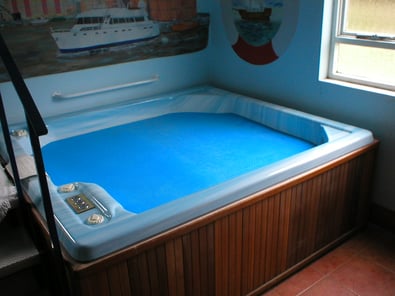I confess – despite an acute awareness of the potential dangers of hot tubs and other similar spa facilities combined with a long-held professional belief that caution is the order of the day – I’m continually drawn to the idea of embracing what seems to be an excellent environment for relaxation.
However, the message of the water hygiene professional is rather more mundane, one of cleaning routines and maintenance tasks, disinfection, and, God forbid, water safety record keeping. This may be a clue to the imbalance in the ever-increasing installation and use of ‘hot tubs’ and the potential for irregular or ad hoc implementation of maintenance regimes.
The HSE's definition of a Hot Tub
These days, a hot tub tends to be more than a wooden-staved barrel filled with warm water, and colloquially, the term hot tub is now commonly used to describe a variety of ‘jetted baths’.
The Health & Safety Executive’s HSG282, The control of legionella and other infectious agents in spa-pool systems, describes such facilities as
‘…a self-contained factory-built unit for indoor or outdoor use, and is designed for sitting in. They are typically filled with treated water, maintained at a temperature above 30 °C, fitted with air jets and aerated. They are generally designed for a small number of discrete bathers where the water is not changed, drained or cleaned after every use. Hot tubs are not for swimming in and do not have a balance tank. These are likely to be small units, but with regular daily usage and the above factors, along with the turnover of water, must be considered as part of the risk assessment’.
So… to the title of this blog, “Could Legionnaires' Disease be lurking in your hot tub?” and a notable reminder which came to press in September 2019:
In the US, at the North Carolina Mountain State Fair, 141 cases and four deaths from Legionnaires' disease were reported, along with further cases of Pontiac fever confirmed from the same source - https://www.nytimes.com/2019/10/06/us/Legionnaires-disease-north-Carolina.html
In short, microbiological hazards can and are frequently found in hot tubs. Water in hot tubs should be free from irritant substances, chemicals and infectious microbiological agents at levels which may be harmful to health.
Can you find Biofilm in your hot tub?
Biofilm is a complex association of microorganisms which can adhere to hot tub surfaces, particularly in the associated plumbing systems and internal pipework, where it can be difficult to remove. Biofilms in hot tubs can and often do lead to cloudy water, odours, scale buildup on the heater, and corrosion of the heater, pumps, filtration system and jets. Internal filters can also be colonised, which then become a breeding ground for unwanted bugs if not managed and maintained correctly.
The risk of microbial growth increases with the introduction of nutrients such as mucus, saliva, perspiration, dead skin, suntan lotion, spray tans, cosmetics, shampoo and soap residues, urine, faecal matter and hair. These nutrients can serve as building blocks for microorganisms in biofilms as they establish colonies in low-flow areas of hot tubs or spa pools.
Crucially, poorly designed or poorly managed hot tubs and spa-pool systems can create conditions that increase the risk of acquiring an infectious disease.
Legionella and other hazards in your hot tub
HSG282 very clearly highlights the various microbiological hazards that are ‘commonly’ associated with hot tubs:
 Legionella species
Legionella species
Legionellosis is a collective term for diseases caused by the legionella organism, including the most serious Legionnaires’ disease, as well as the similar but less serious condition of Pontiac fever. There have been a number of outbreaks linked to spa pools, including those in leisure centres, hotels, holiday homes, cruise ships and those on display.
-
Everyone is susceptible to infection, but there is a heightened risk with:
- increasing age, particularly those over 45;
- smokers and heavy drinkers;
- those with existing respiratory diseases or certain illnesses and conditions such as cancer, diabetes, heart and kidney disease;
- those with an impaired immune system.’
Coliforms and Escherichia coli
'The presence of E.coli in spa-pool water is an indication that faecal material has either entered the water from contaminated skin, or has been accidentally or deliberately introduced. Coliforms occur on vegetation and in soil as well as faeces, so their presence alone may indicate external contamination. The presence of coliforms and/or E.coli also confirms that the treatment has failed to control this contamination.’
Pseudomonas aeruginosa
'Numerous outbreaks of folliculitis caused by P.aeruginosa are associated with spa pools and hot tubs. Folliculitis presents as a red rash caused by infection of the hair follicles, usually about 48 hours (range 8 hours–5 days) after immersion in pool water, and is related to the duration of immersion as well as the degree of contamination of the water. Children are generally more susceptible than adults.’
Mycobacterium avium and Mycobacterium species
'Respiratory disease has been associated with non-tuberculous mycobacteria, particularly Mycobacterium avium, in association with spa pools and hot tubs.’
Other potential infections
‘Other infections such as amoebae, parasitic and other gastrointestinal infections, furunculosis (caused by Staphylococcus aureus) and Molluscum contagiosum (a viral skin infection producing papillomas) have also been associated with using spa pools.’
Guidance and Management
The Health & Safety at Work etc. Act 1974 [HSWA] does not apply to the private owners of spa pools or hot tubs, or where there is no financial gain, and they are for the exclusive use of the owner, their family and occasional guests. That said, to ensure its safe use, the spa pool or hot tub should be used and maintained in accordance with the manufacturer’s instructions.
However, domestic-type and commercial spa pools or hot tubs used as part of a business activity are undoubtedly subject to the general duties under the HSWA. Within commercial settings, there is a higher number of users than in domestic-type spa pools, and the number of bathers cannot be clearly anticipated or recorded. There is a legal requirement for these systems to be managed and controlled in proportion to the risk. A Legionella risk assessment should consider the type of system/pool and its intended use.
Lessons Learnt
The British and Irish Spa and Hot Tub Association some years ago delivered an article on lessons learnt post the announcement of the £1-milion fine for JTF Warehouse, following the death of two people from Legionnaires’ disease and a further 20 people contracting the disease, citing this as ‘a landmark moment for the hot tub industry in the UK’ and that ‘every reputable hot tub company is aware that these deaths were completely avoidable had JTF Warehouse put in place a robust water hygiene management regime’.
How should you managed your Hot Tub?
The HSE’s HSG282 provides excellent guidance on minimising Legionella risks whilst using hot tubs and similar equipment. The guidance is based on the key principles of the COSHH Regulations, which provide a framework of duties designed to assess, prevent or control the risks from hazardous substances, including chemicals and biological agents such as legionella and other infectious agents, and take suitable precautions.
The essential elements are:
- Legionella risk assessment;
- Prevent exposure or substitute with a less hazardous substance or process/method, where reasonably practicable;
- Control exposure if prevention or substitution are not reasonably practicable;
- Maintain, examine and test the control measures;
- Provide information, instruction and Legionella training for their employees;
- Provide health surveillance of employees, where appropriate.’
Read more about Legionella in hotels here >
Feel free to reach out if you have any questions about the issues mentioned above or if you would like to consult with one of our experts on water hygiene.
Editors Note: The information provided in this blog is correct at date of original publication - November 2019. (Revised August 2025)
© Water Hygiene Centre 2025










